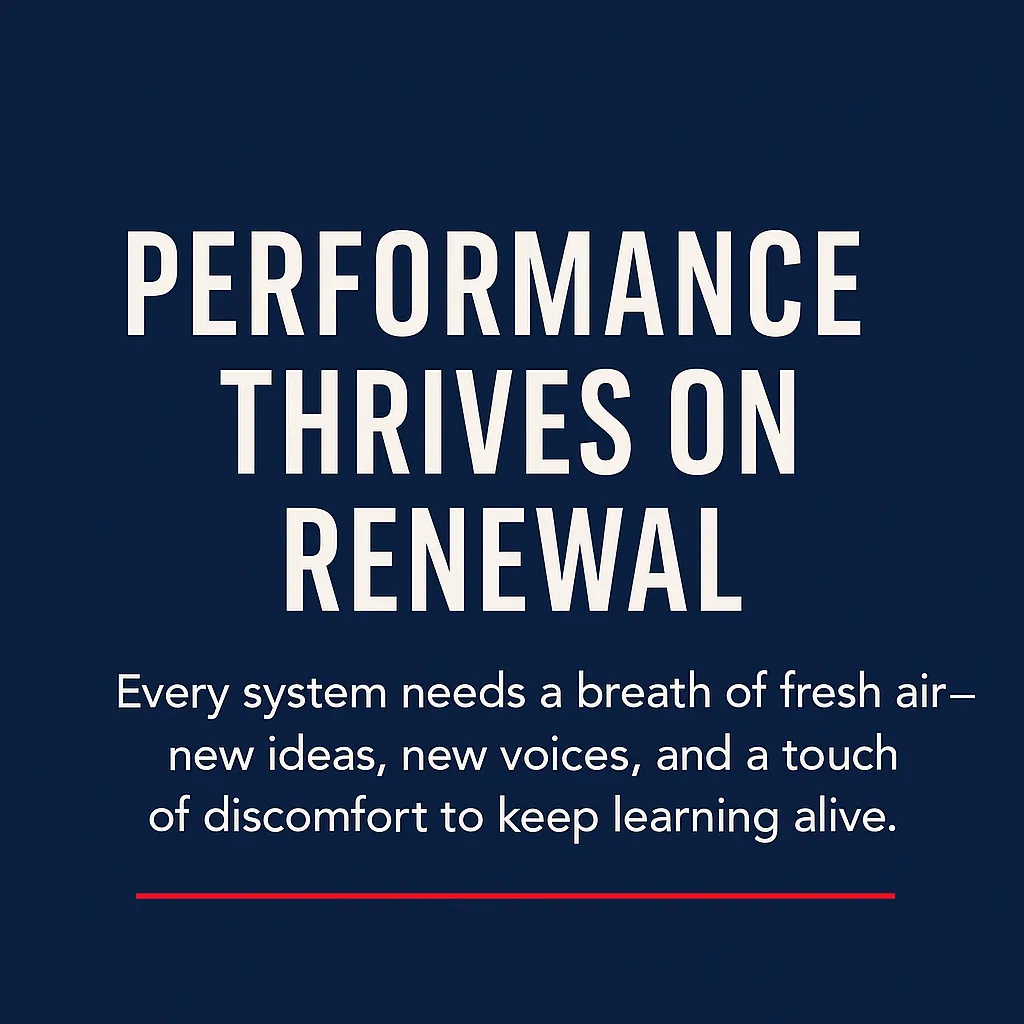
Team Performance Thrives on Renewal
When agile becomes a hat, not a head, teams stop evolving.
Without periodic external energy, all systems trend toward inertia. Teams stabilise around comfort; only an external edge can safely create productive discomfort. Yet as agile roles have been absorbed, diluted, or distributed, the loss of a dedicated catalyst has left many teams directionless. They continue to deliver, but without awareness—performing the rituals of agility without its spirit. Most still hit their dates and complete their work. But something vital has shifted: the willingness to examine how they work, and the energy to improve it.
The Drift Toward Comfort
Every team begins with energy—curiosity, tension, and the will to figure things out. But over time, the drive to improve gives way to the need to stay comfortable. Teams start following patterns blindly. Ceremonies continue, metrics look healthy, and work gets done. But something subtle and vital has been lost: the willingness to be uncomfortable in pursuit of better.
This isn't about apathy or laziness. It's about systems doing what systems naturally do—seeking stability. The longer a team operates without meaningful external challenge, the more that stability becomes mistaken for success. The retro becomes a checkbox. The stand-up becomes status reporting. And because the system is still delivering, no one questions whether it's still learning.
A Pattern Worth Noticing
Recently, I was working across six agile teams in a large, mature organisation. Half of them had agile team facilitators who were bright, motivated, and only a year or two out of university. They were facilitating people much older than themselves—engineers and analysts with decades in the organisation—while trying to learn agile on the fly.
None had received formal training in facilitation or agile coaching. They were piecing things together from fragments: a bit of JIRA documentation, a few online courses, whatever they could glean from others. They were doing their best, but they were learning the role while performing it—and their teams could feel the difference.
What struck me wasn't their effort. It was how quietly the teams had accepted this. No one pushed back. No one asked for better. The facilitators wore the hat, the ceremonies ran on schedule, and everyone called it normal.
Here's the pattern I'm seeing everywhere: agile roles like coach, facilitator, or change lead have become "hats"—responsibilities distributed across delivery people alongside their primary jobs. The assumption is that agile is now common knowledge, so why fund it as a dedicated role?
But when everyone owns the process, no one owns the energy. The team loses what matters most: that outside edge—the person whose sole job is to look across the system, notice what's become invisible, and create the productive friction that keeps improvement alive.
Why External Energy Isn't a Luxury
The outsider's role isn't to manage or to deliver. It's to observe what those inside cannot.
An external facilitator can spot power imbalances that have become normalised. They can question decisions that have stopped being questioned. They can provoke reflection without the fear of hierarchy that silences internal voices. That outside perspective doesn't just challenge; it restarts the conversation.
Here's what's important: this isn't about bringing in experts to fix broken teams. It's about maintaining the reflective capacity that keeps healthy teams evolving. Even the most mature, high-performing organisations lose this without deliberate attention.
Without periodic external energy, systems normalise their dysfunctions. The daily rhythm of agile becomes self-reinforcing—efficient, predictable, but slowly stagnant. People stop asking "why" and start asking "what's next on the backlog." The ceremonies continue. The metrics improve—until slowly, they don't.
Practical Ways to Reintroduce External Energy
You don't need a major intervention or a year-long transformation programme. Sometimes the reset is simpler:
A facilitated retrospective led by someone outside your immediate system. Not to judge, but to help the team see itself from a different angle. What patterns do outsiders notice that insiders have stopped seeing?
A short "ways of working" review—annual or quarterly. Not to prescribe, but to reconnect: Why do we do this ceremony? Is it still serving us? Where have we drifted from what we actually value?
Periodic training or coaching that reintroduces rigour. Not as a one-time event, but as a regular rhythm—a reminder that agile isn't a state you reach, it's a practice you maintain.
What matters isn't the label—coach, facilitator, consultant. What matters is consistency. External energy needs to come regularly enough that it becomes part of the system's rhythm, not a surprise intervention.
The Real Cost of Comfort
High performance doesn't die in chaos. It dies quietly in comfort—in rooms where everyone agrees, where tension is avoided, and where the system stops being examined.
The hardest part isn't implementing agile. It's maintaining the discipline to keep questioning it.
Teams don't burn out from working too hard. They fade away from working the same way for too long. And the fade is so gradual that by the time leadership notices, the habit has become deep. The team isn't broken enough to fix, but it's not growing anymore either.
The Question Worth Asking
If you want teams to sustain high performance, they need access to an outside edge—someone or something to challenge the norm and reawaken the curiosity that got them moving in the first place.
Not because they're failing. But because comfort is the default state of all systems, and growth requires something that pushes back against it.


